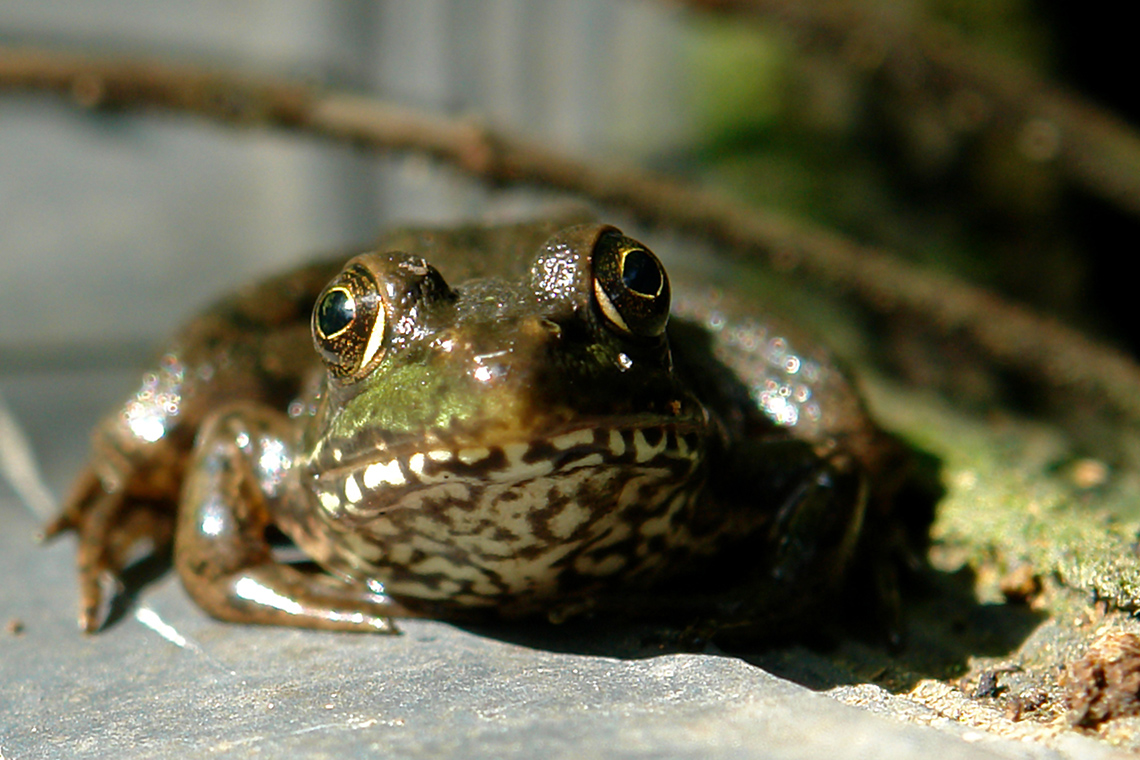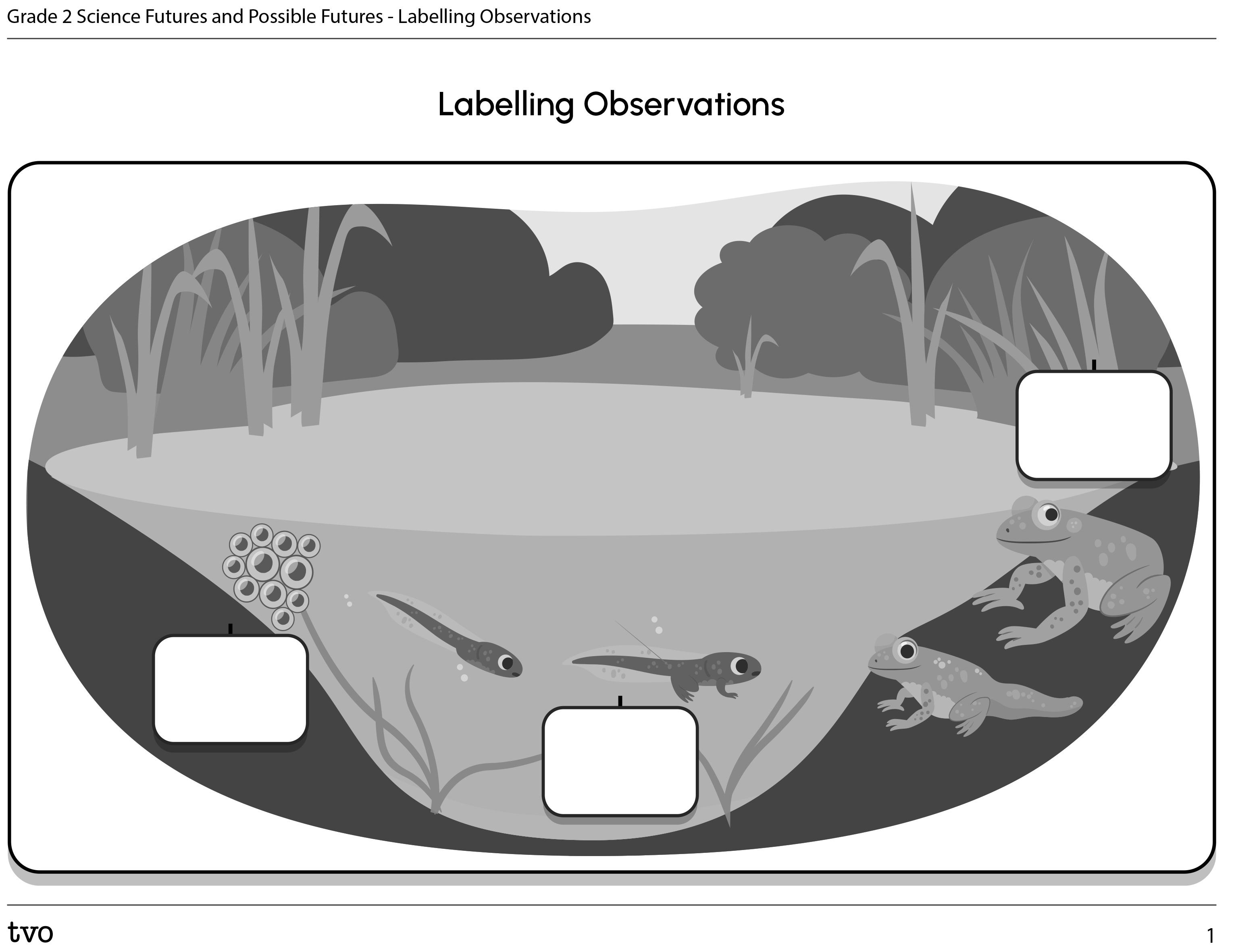Minds On
On and under the ice
Many animals live on icy surfaces all year. Some live in icy water all year.
Explore the following image of arctic animals.

Can you name the animals in the image you previously explored?
Match each image to the animal.
The temperatures in the far north stay cold enough that there is ice all year. Ice forms from water that freezes when it is cold. This turns liquid water into a solid that is slippery and sometimes is a dangerous surface to be on top of.
What happens to the animals below the icy surface?
Let’s investigate in this learning activity!
Action
Life below the icy surface

Did you know that some animals spend parts of their lives under ice and snow, and then summers in the hot sun?
Complete the following Have you ever checklist. Check “Yes” or “No” for each item in the list.
Have you ever…
|
noticed a frog hopping around on the snow? |
||
|
noticed a turtle sliding across a frozen pond? |
||
|
noticed a person having to swat away mosquitos in the winter? |
There are some parts of the world where the seasons change, like in Canada. When seasons change, animals, even humans, need to adapt to changing air and water temperatures.
What does it mean to adapt? It means that there are special body parts or behaviours that help a living thing survive in different environments.
Animals, like fish, reptiles, and amphibians, and even insects who live in and near water need to be able to survive warm water in the summer, and frozen icy ponds and land in the winter.
Let’s focus on the frogs
Scientists use research skills to help them understand the world around them. Making observations about where an animal lives can help us understand how it adapts to winter.


Time to learn! We can learn things from different places and people.

It’s time to record what you have learned. You could write it down or make an audio or video recording.
Use the following video, picture, and description to record what you are learning about where bullfrogs and wood frogs live as adults.
Let’s begin with bullfrogs!
Explore the following video of a bullfrog.
Now that you have explored the video, consider the following question and choose the correct answer.
Good work! Let’s try another frog: the wood frog.
By winter, one of these frogs will live under the ice, and one will live under the snow. These two frogs need to have two very different plans for survival.
Pause and Reflect
Pause and reflect
What clues helped you understand where the bullfrog and wood frog live?
Record your answers in a method of your choice.
Let’s learn about the life cycle of a frog to help us understand how they adapt to their changing environments.
Cycles through the spring and summer seasons
Frogs lay their eggs in the water. They make sure to do this in the spring when the eggs will have time to grow into tadpoles who can swim, and then adult frogs who can hop around before the water gets cold again.
Explore the following image and description that displays the life cycle of a frog.

Tadpoles
We’re going to explore tadpoles.
Check out the following video of tadpoles swimming:
Now, let’s check out a video from TVOKids. In this video, Sheryl from Ontario Parks helps Howie and Baboo investigate how tadpoles turn into frogs.
Before you explore the video, make a prediction!

Predicting is when you make a guess about what you think will happen in your experiment.
What do you think will happen?
When you make a prediction, you will …
- think about what you already know
- explain what you think is going to happen
Answer the following questions about tadpoles.
By the time a frog is an adult, it is summertime. The adult frog can live in the warm water or lay in the warm sun. The word for animals that can survive on land and water is amphibian.
Deep below the ice and snow
An adult bullfrog survives the winter by finding a spot under the ice where it can live in the water that isn’t frozen.
The frog can still get oxygen from the water and might move around very slowly. It is in a hibernating, wintery, sleeping state.
Frogs can live in frozen ponds by slowing their heart rate and its body’s needs for the winter.
The following image reveals a bullfrog sleeping in a frozen pond.

Once the water starts to warm up, so does the frog, and spring brings new warmth and energy to the bullfrog. With this warmer temperature, the bullfrog moves quickly again.

Pause and Reflect
Pause and reflect
How does the bullfrog behave differently in the winter and in the summer? What makes this change happen?
Record your answer on the computer, on paper, in a recording, or in a method of your choice.
A cozy hole in the mud
Like the bullfrog, the wood frog also adapts to survive the winter.
A wood frog digs itself a hole under the leaves or in the mud to create a home for winter. It will do the same as the bullfrog: slow its body down and wait for it to be warm again!

Pause and Reflect
Pause and reflect
How does the bullfrog behave differently in the winter and in the summer? What makes this change happen?
Record your answer on the computer, on paper, in a recording, or in a method of your choice.
Show what you know
Answer the following true or false questions about frogs.
Consolidation
Putting it all together!
A scientist who is studying the changes in animal behaviours through the seasons needs to keep track of their observations.
Explore the following image of a frog life cycle. The stages of a frog’s life fit together in a cycle. Your task is to put the frog’s life cycle in each answer box in the correct order!
Complete the following fillable and printable Labelling Observations document. You will need to fill in the three blank spots on the document to label the life cycle of a frog. You can also complete this activity using another method of your choice.
When you’re ready, press the ‘Answers’ button to reveal the answer to the Labelling Observations activity.

True or false?
Check off all of the following observations that are true. Record the true observations in your field journal of observations.
What is true about frogs?
When you’re ready, press the ‘Answer’ button to reveal which statements are true and which are false.
- Amphibians can live in water and on land. True!
- Frogs migrate south during the cold winters. False.
- Frogs stop moving and slow their hearts when they live under ice and snow in winter. True!
- Eggs, tadpoles and froglets need to live in the water. True!
- Eggs are laid in spring. True!
What a Grade 2 student can do!
This learning activity connects new and existing approaches for young scientists to create positive changes in their communities.

Changing temperatures mean that animals need to adapt. Grade 2 students can:
- record and share their observations with others so that other can learn about what they’ve noticed about animals and cold temperatures where they live
- leave animals alone as they are growing through their lifecycle. Collecting any animals from nature, including tadpoles, may interrupt their growth.
What is one important message about frogs and their behaviours that help them survive the winter would you want to share with others?
Record your answer in a method of your choice.
Reflection
How do you feel about what you have learned in this activity? Which of the next four sentences best matches how you are feeling about your learning? Press the button that is beside this sentence.
I feel…
Now, record your ideas about your feelings using a voice recorder, speech-to-text, or writing tool.
